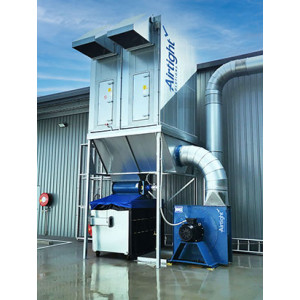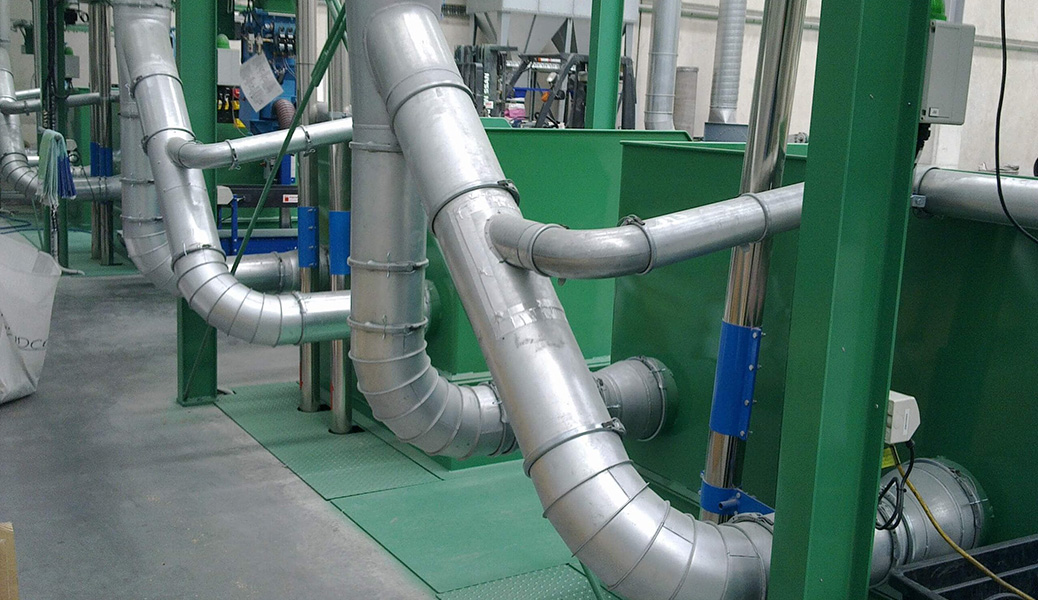Understanding the differences between the many dust collection systems on the market today is often challenging as there are many types and styles to choose from. Dust collection systems design and construction can vary depending on the type of dust collector and include the following:
Important!
Not all dust collection methods and technologies are suited for all applications. A certain separation, media or cleaning technology is design for a certain application. A suboptimal product spec can result in poor performance, product failures and commonly in frequent bag changes and high running cost.
What is a Cyclone Dust Collector?
Cyclone dust collectors use centrifugal force to separate air and materials. The force pulls dusty air into a scroll type inlet forming a cyclonic motion. The vortex within the dust collection chamber flings large dust particles toward the outer walls of the dust collection chamber. Once the particles reach the outer walls, gravity and friction force the larger particles to descend into a receiver. The filtered air and fine particles then leave the collection chamber through the internal vortex tube.
Advantages of Cyclone Separator Dust Collection Systems:
- Cyclone dust collectors are simple and low cost.
- They have a lower initial investment cost.
- They have a simple construction and, typically, no moving parts.
- Maintenance is minimal on a correctly dimensioned cyclone
- Cyclone dust collectors have the highest collection efficiency, over 90%, with large particulates over 20 microns in size.
- They are able to work with both wet and dry materials.
- They can tolerate a wide range of temperatures.
- Cyclones can stand as low-maintenance standalone dust collectors and do not require compressed air for cleaning.
Disadvantages of Cyclone Separator Dust Collection Systems:
- Cyclone dust collectors are not effective on small particulates.
- Cyclone dust collectors are not effective with sticky or adhesive substances. They stick to the outer walls of the collection chamber.
- These systems can be expensive to operate because of the pressure drop they experience.
- Not suitable for metro area without post fines filtration
Common Industrial Applications for Cyclone Dust Collectors
Cyclone dust collectors are most commonly found in facilities where fibrous dust is managed, such as:
- Woodworking facilities
- Grain facilities
- Fiberglass production facilities
Cyclone dust collectors are often used as pre-filters for other types of dust collection systems including pulse jet dust collector and cartridge collectors.
Large, irregularly shaped particles often generated at these facilities are known to clog fine dust collectors, such as baghouse and cartridge filters. Using a cyclone dust collector as a pre-filter helps:
- Reduce the amount of dust that reaches the baghouse and cartridge cloth filters.
- Minimize filter maintenance and service costs.
- Reduce the need for time-consuming filter cleanings. Cyclones are quick and easy to clean between product batches and catch large, salable particulates.
Engineering a Cyclone Dust Collector
Your dust collection manufacturer engineering team will help customize the cyclone dust collector system to fit specific application needs.
They will take into consideration the following five factors:
- Dust control needs
- How large are the particulate contaminants to be collected?
- Is ventilation air exhausted or returned to the manufacturing area?
- Is dust generated only during a particular process or is it generated constantly?
- Budget
- A cyclone dust collector can be less costly up front than a baghouse or cartridge dust collector, but will it meet the long-term particulate matter collection efficiency needs for the facility?
- Can a baghouse perform reliably without the need for an upstream cyclone?
- Using two air-material separators results in increased energy costs.
- Adding an upstream cyclone decreases maintenance costs if cleanability is a requirement.
- Pre-Filtering Needs
- Consider the size of the airborne particles and their distribution within the air or gas stream.
- If the application is collecting large particles, a standalone cyclone may be sufficient.
- If the application requires filtering large and small particles, a cyclone dust collector may help as a pre-filter for baghouse and cartridge collectors.
- System Footprint
- Where is the dust collector to be installed?
- A standalone cyclone system is relatively compact, highly efficient and cost-effective.
- If the cyclone system needs to be combined with a baghouse or cartridge collector, more floor space is required.
- Health Benefits
- An affordable cyclone dust collector can greatly improve working conditions for staff decreasing airborne particles.
What is an Electrostatic Precipitator?
An electrostatic precipitator (ESP) removes pollutants from a gas stream by using the force of an induced electric charge to charge the particles in the gas stream.
These charged particles are then drawn to collection plates with the opposing charge where they accumulate. The remaining air passes through the plates unimpeded. Once the collection plates are full, the particulates are shaken off the collection plates using mechanical rappers.
The particulates, wet or dry, are shaken into a hopper and are transported away by a conveyor system for disposal or recycling.
Electrostatic precipitators are highly effective at removing particle pollution. Some ESP’s can:
- Achieve efficiencies as high as 99.9%.
- Capture fine particles smaller than 2.5 microns in diameter.
- Handle large volumes of gas at various temperatures and flow rates.
- Remove either solid particles or liquid droplets.
Common Industrial Applications for Electrostatic Precipitators
ESP are used in smokestacks and other flues most frequently at industrial facilities and power-generating stations. They are often combined with denitrification units to remove nitrogen oxides and scrubbers or other devices to remove sulphur dioxide.
ESP are also used in various industrial and household applications:
- Removing dirt from flue gasses in steam plants
- Removing oil mists in machine shops
- Removing acid mists in chemical process plants
- Cleaning blast furnace gasses
- Removing bacteria and fungi in medical settings and pharmaceutical production facilities
- Purifying air in ventilation and air conditioning systems
- Material recovery from gas flow
- Includes oxides of copper, lead and tin
- Separating rutile from zirconium sand in dry mills and rutile recovery plants
Industries that use ESP include:
- Cement plants
- Fossil fuel-fired boilers
- Hazardous waste incinerators
- Lead/zinc/copper smelters
- Municipal waste incinerators
- Petroleum refineries
- Power-generating stations
- Pulp and paper mills
- Steel mills
Engineering an Electrostatic Precipitator
An experienced engineering team will help determine the size and type of ESP required for specific processes.
ESP are designed to work on gas streams with specific temperature and moisture characteristics. Dry ESPs, most commonly used, operate above the dew point of the gas stream. Wet ESPs operate with saturated airstreams that have 100% relative humidity. The main difference between the two classifications is how their collector plates are cleaned.
- Dry ESPs
- Collector plates are cleaned by mechanical rapping.
- Wet ESPs
- Collector plates are cleaned by rinsing them with water.
- They are most effective with:
- Humid gasses
- Gasses that contain combustible particulates
- Gasses that contain sticky particulates with low resistivity
- In industrial settings, wet ESP are commonly used to remove oil, resin, tar and sulfuric acid mist.
The performance of ESPs is affected by particle resistivity.
- Particles with high resistivity are slow to lose their charge and hold tightly to collection plates eventually causing a negative charge to build up on the plates preventing other particles from adhering to the plates.
- Particles with very low resistivity rapidly lose their charge and are thrown back into the gas stream.
ESP are not used to control gaseous emissions. ESP have a large footprint and a high initial cost, but they have low operating costs, a long service life and typically require minimal maintenance.
The design of the ESP system is normally completed by the manufacturer who takes into consideration many variables including:
- Gas flow rate
- Particle size and size distribution
- Particle resistivity
- Gas temperature in the system
- Chemical makeup of the particulate matter
- Precipitator size
- Power input
What is a Wet Scrubber?
Wet scrubbers remove particulates, vapours, odours and gasses from industrial exhaust streams by introducing a liquid, typically water, into the stream. The liquid cools the gas flow and collects particulates and gasses through agglomeration, adhesion and/or encapsulation.
Wet scrubbers are commonly found at Petroleum Refineries, Chemical Processing Facilities, Acid Manufacturing Plants and Steel Manufacturing Companies.
Wet scrubbers differ in how they expose the exhaust stream to the liquid scrubber.
- Packed bed scrubbers
- The exhaust stream is sent up through beds of tower packing while a scrubbing liquid is sprayed downward onto the beds.
- The material and shape of the tower packing are chosen to maximize the gas to liquid contact and prevent excessive pressure drops.
- Packed beds are an ideal choice for wet scrubbers that need to remove gaseous pollutants.
- Venturi Scrubbers
- ○Exhaust gasses pass through an hourglass-shaped chamber at high pressure while scrubbing liquid enters the gas stream at a lower pressure.
- The high pressure of the gas turns the liquid into a fine mist, which traps gaseous and particulate matter.
- Requires a lot of power.
- Spray Towers
- The exhaust stream enters a chamber fitted with spray nozzles that release a mist.
- The mist collects the pollutants in droplets carrying them to a treatment system while the cleaned gas rises.
- Advantages:
- Disadvantages:
- Reduced efficiency.
- Treatment systems are required.
- Heavy maintenance requirements to keep spray nozzles clear.
- Ideal for facilities that require a lower power wet scrubber to control gaseous pollutants.
- Cyclone spray chambers
- Within the scrubber chamber, a cyclonic movement is created by integrating sprayers and high speeds.
- Gas enters the chamber at high-speed moving naturally around the spray chamber and becoming saturated by the liquid.
- As the gas rises, it passes through straightening vanes that break up the cyclonic movement before the clean gas exits the chamber.
- Orifice Scrubbers
- Gasses pass over a pool of scrubbing liquid.
- The gasses collect droplets that turn into mist.
- As the gas rises, it strikes several baffles. Striking a baffle knocks the pollutant-containing liquid out and the cleaned gas continues to rise.
Advantages of Wet Scrubbers
- The most effective method for removing both dust particulate and gasses in a single system.
- Handle moderate to high concentrations of pollutants.
- Handles combustible and nonflammable metal dust contaminants efficiently and cost-effectively.
- May neutralize corrosive gasses and particles.
- Ideal for high temperature applications.
- Ideal for gas streams with moisture that would quickly clog a dry dust collector.
- Are ideal for a wide range of manufacturing processes and applications.
Disadvantages of Wet Scrubbers
The main disadvantages of wet scrubbers include:
- The need to treat the contaminated liquid and dispose of the waste product.
- The cost of waste disposal may be high.
- They have a higher risk for corrosion.
- They may require regular maintenance.
Engineering a Wet Scrubber
An experienced engineering team will take many factors into consideration when choosing the best wet scrubber system for a specific application.
A few of these considerations may include:
- The nature of the particulate/dust to be removed.
- The particulate size distribution.
- The initial pollutant loading/ concentration in the waste stream.
- Whether the particulate is flammable or combustible.
Dust collection systems require ongoing maintenance after installation. Consideration should be paid to the long-term maintenance cost of a new system and how to engineer a solution that will reduce long term maintenance costs. A reputable dust collection engineering firm will also provide an aftercare service that will provide:
- Preventative maintenance
- Site inspections
- Consulting and Diagnosis
- Smart automation
- Remote 24/7 system monitoring
- Fault monitoring and reporting
Filtration Media Dust Collection Systems
There are several types of dust collection systems that use filter media to remove dust particulate from the work environment. These include shaker, reverse air, and pulse jet systems. Pulse jet are the most common and include baghouses, cartridge collectors and bin vents.
What is a Shaker Style Dust Collector?
Shaker Style dust collectors use woven filter bags which are hung and tensioned from the top of the filter housing and attached with an open bottom to a tube sheet.
A shaker baghouse is designed so that when an airstream enters below the filter bags it is pulled upwards and through the interior of the bags. Once sufficient dust cake builds on the inside surface of the filters, they can be cleaned by mechanically shaking the filters until the dust falls into a hopper system below the dust collector. Finally, clean gas is exhausted towards the top of the collector.
Shaker baghouses can be used in facilities where there is no compressed air available and are most suitable for applications where the baghouse will experience lighter dust loads and only run for shorter periods of time, i.e., > 4hours between shut down cycles.
What is a Reverse Air Baghouse?
A reverse air baghouse can be used in large scale air handling applications. These systems require specialty fabric filter bags, which typically consists of a compression band top with a cap and hook. The bottom filter bag configuration can vary from a compression band, double beaded snap band, or corded.
This style of dust collector accumulates dust in a similar way to a shaker baghouse. Dirty airstream enters the baghouse, then it’s pulled through the bags from the inside. The difference in a reverse air versus shaker is in how filter bags are cleaned.
Once dust cake is accumulated on the inside surface of the filter bags, cleaning is accomplished by injecting clean air into the system in a reverse direction. This action pressurizes the compartment, which allows the filter bags to partially collapse, and the dust cake to fall into the hopper located below. In general, reverse air baghouses can generate a lower cleaning air pressure versus the compressed air pulses of a pulse-jet. This makes the reverse air technology suitable and cost effective in some applications while unsuitable in others. Engage a reverse air specialist for advice.
Common applications that use reverse air dust collector include:
Advantages of Wet Scrubbers
- No compressed air required to operate
- High performance outcome on correct design and application
- Long bag life and low pressure drop over the filter bags
- Low power consumption and low running cost
- Reliable and cost-effective technology
Disadvantages of Wet Scrubbers
The main disadvantages of reverse air filters include:
- Not suitable for all applications
- Sensitive to correct filter media selection
- The conservative filtration velocities required result in larger baghouse footprint
What is a Pulse Jet Dust Collector?
A pulse-jet dust collector may be one of the most common styles of dust collection systems used across various industries. A pulse-jet baghouse differs in the way a shaker or reverse air will collect dust. In a pulse-jet, dirty airstream flows through from the outside to inside the filter bags, finally expelling clean air through the top of the system.
To clean dust that accumulates outside of the filter bag, a blast of compressed air is injected through a blowpipe via a venturi over each row of filters. This short blast of compressed air breaks up the dust cake that has accumulated on the outside of the filters and allows dust to fall into a hopper below.


 Menu
Menu





